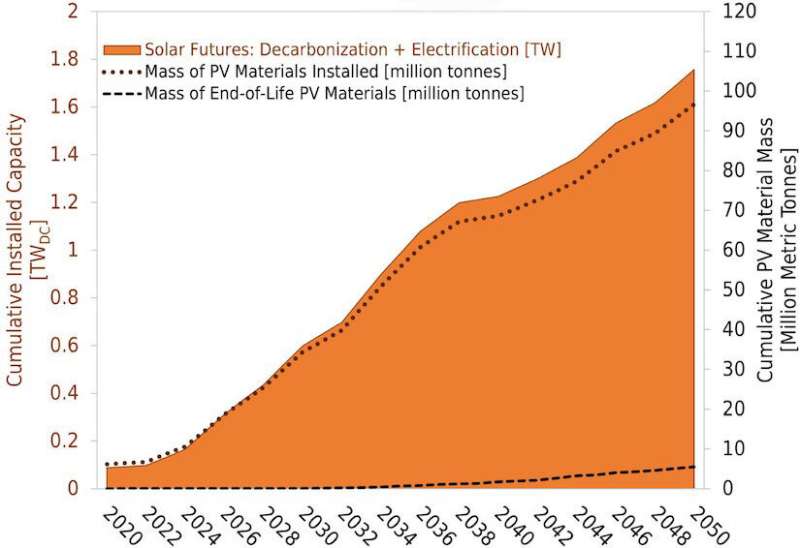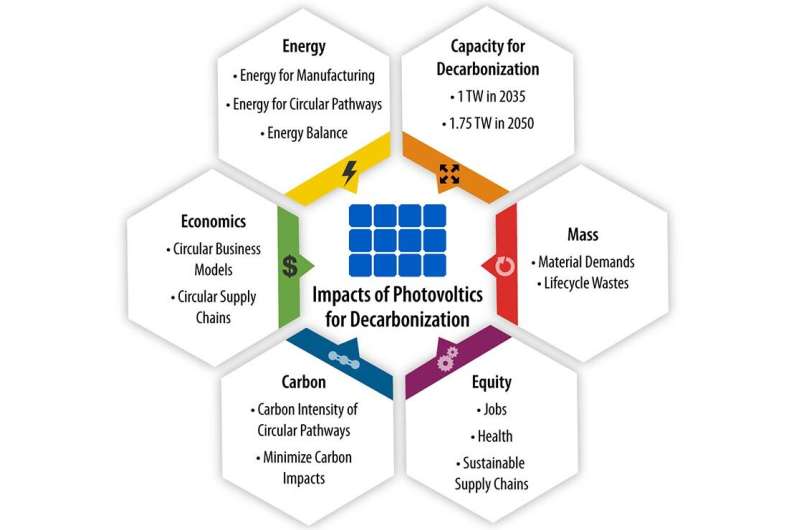Using PV deployment projections from the U.S. Department of Energy’s Solar Futures Study and the PV in the Circular Economy tool, NREL researchers modeled PV module material flows through 2050. The mass of PV modules that are expected to be installed (dotted line) and the mass of end-of-life modules (dashed line) are shown for a baseline scenario in which PV modules with a 35-year lifetime are deployed. Credit: National Renewable Energy Laboratory
To meet its 2050 decarbonization goals, the United States will need to install up to 20 times more solar photovoltaic (PV) modules than are installed today. While any approach will require a vast scale-up of PV manufacturing and installation, new NREL research suggests that longer-lived PV modules could ease the amount of materials and manufacturing required.
These are among the key findings of a team of NREL researchers who conducted one of the first quantitative analyses of how PV module lifetimes and recycling rates can affect the flows of PV materials through 2050 in a 100%-decarbonized U.S. grid. Their modeling of different "what-if" scenarios is detailed in a new journal article in PLOS ONE, "Circular Economy Priorities for Photovoltaics in the Energy Transition."
"PV is a no-brainer for sustainability as a source of clean energy, but there are still concerns about waste, material impacts, and energy justice, especially considering how fast PV manufacturing must grow to meet decarbonization goals," said Silvana Ovaitt, an NREL PV sustainability researcher and an author of the article. "With this work, we hope to put these challenges into perspective and quantify potential solutions."
"When considering a sustainable PV supply chain, there is a tendency to jump straight to recycling as the solution, when there are a lot of other circular economy levers to try first, like lifetime extension," said Heather Mirletz, the article's lead author and a Ph.D. student at the Colorado School of Mines. "Our PV sustainability team gets a lot of questions about repowering existing PV installations and PV recycling. Ultimately, we want to advise how to design and deploy PV in the most sustainable way possible, so we first need to understand the material flows in the context of the energy transition."
How module lifetime and recycling rate drive new materials and waste
Among the 336 scenarios the authors considered, which combined a range of module lifetimes and recycling rates, two scenarios represent upper and lower bounds of possible approaches to a circular economy of PV modules—modules with an extended 50-year lifetime and shorter-lived, 15-year modules with a high rate of closed-loop recycling (meaning materials are reused in new modules instead of being downcycled into simpler products). These were compared to a baseline scenario that assumed a 35-year module lifetime and a low recycling rate that is reflective of current technology. While 15-year modules are unlikely to be produced and 50-year modules are not yet available, the two scenarios act as points of comparison.
This journal article considered the flow of mass for various module materials for material demand and life cycle waste. As the PV ICE tool continues to develop, it will also be able to consider other factors, such as energy flows, environmental impacts, and social implications. Credit: National Renewable Energy Laboratory
Longer module lifetimes could reduce new material demand by 3% over the baseline scenario by reducing the need for additional solar deployment to achieve the same goals in the United States. Because the short-lived modules require an additional 1.2 terawatts of replacement modules to maintain PV generation capacity through 2050, they must reach closed-loop recycling rates of 95% or higher to avoid requiring larger quantities of new materials than the 35-year baseline scenario. The modeling considered only the flow of materials for crystalline silicon modules, which dominate today's PV market, but it can be applied to other PV technologies.
While this modeling focused on material flows—not yet considering aspects such as energy demand and carbon intensity of manufacturing, equity, and economics—the authors noted three significant trends:
- Long-lived modules not only reduce demand for new material, but also provide a longer grace period in which to develop and implement end-of-life recycling or remanufacturing processes, as it will be longer until they begin to retire.
- Shorter-lived modules must achieve high rates of recollection and recycling/remanufacturing to avoid consuming additional new materials.
- Glass composes the majority (by mass) of today's PV modules. When developing recycling or remanufacturing processes, it will be important to consider PV glass to ensure a steady supply of high-quality glass in addition to silicon and metals.
"Longer module lifetimes make it easier to achieve our PV deployment goals for decarbonization," said Teresa Barnes, an author on the article and manager of NREL's PV Reliability and System Performance Group. "We can avoid excess replacements and additional manufacturing by building systems right the first time. Recycling short-lived modules sounds attractive, but our mass balance and capacity calculations show it might limit PV capacity. Our upcoming research on energy balance should further guide us toward the most sustainable and successful pathways for PV deployment."
NREL-developed tool unlocks new insights
To model the flows of PV materials through 2050, the NREL team leveraged a tool they created called PV in the Circular Economy (PV ICE). PV ICE uses the latest data from the PV industry to model the flow of PV materials over the next several decades, helping predict the effects of different market trends, technological developments, and government policies.
Developed by a small team in NREL's PV Reliability Group, the open-source tool consists of two main pieces. The first piece is a set of data files that collect the key properties of today's PV modules—and predictions for future modules—including the quantities of different materials they contain, their expected lifetimes, and their power conversion efficiencies, among others. The second piece is a model that tracks how these modules, materials, and the energies they contain will move through the PV life cycle.
More information: Heather Mirletz et al, Circular economy priorities for photovoltaics in the energy transition, PLOS ONE (2022). DOI: 10.1371/journal.pone.0274351
Journal information: PLoS ONE
Provided by National Renewable Energy Laboratory

























